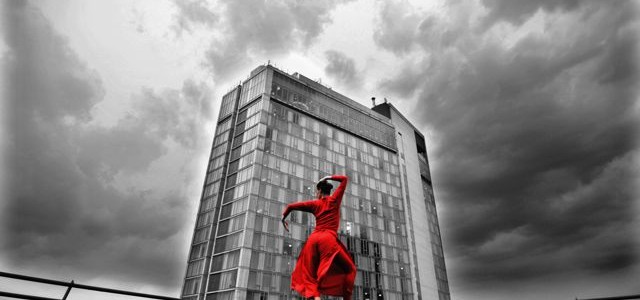“Upon meeting Trisha, I felt a tremendous permission to get dirty and play with movement. She was totally open and made gasping noises when something beautiful happened in the studio.”

Laurel Jenkins Tentindo danced for Trisha Brown with Trisha Brown Dance Company from 2007 to 2012. She continues to work with the company by restaging works and occasionally performing with them.
Q: What was your first encounter with Trisha Brown’s work?
Laurel Jenkins Tentindo: I first encountered Trisha Brown’s work as a dancer. Iréne Hultman, a former Trisha Brown Dance Company dancer, was a visiting professor at Sarah Lawrence College. She introduced Trisha Brown’s basic movement principles to me within her own sensual, spunky, choreography. I loved the mix of specificity, which I enjoyed exercising from years of ballet, and freedom as I was in the process of exorcising years of ballet. Iréne’s approach felt jazzy, feminine, powerful, and playful all at the same time. I was totally captivated by this new way of moving. I loved learning how different joints could initiate a sequence of events in the body. I remember practicing what I learned in Irene’s class on a rooftop in San Francisco—before I knew about Roof Piece.
Q: What were rehearsals like?
LJT: Trisha started working with me once I joined the company. I was involved in making a really difficult partnering section for L’ Amore with Jin, Mindy, and Todd. We were fearless and made movements called things like “the dragon.” I loved dancing with Jin because he was so strong and willing to take risks. I was safe upside down and twirling with him as my partner. Trisha asked us to fly across the room. We did.
Upon meeting Trisha, I felt a tremendous permission to get dirty and play with movement. She was totally open and made gasping noises when something beautiful happened in the studio. That is how we knew we should repeat it. It was thrilling.
Q: What kind of conversations did you have?
LJT: Trisha and I were in a conversation about the art of puppetry. She asked a group of my puppet friends to come into the studio—and we did a three-person puppetry sequence with a bunraku puppet made by Luis Tentindo. It was so fun to see Trisha’s choreographic interests manifested in the puppet. The puppet could do anything partner-wise and never go tired. We never did work with the puppet beyond this rehearsal—but I think we both enjoyed thinking about dance as a moving sculpture—and that partnering was a kind of enormous architecture for humans to traverse.
Q: If you had one Trisha Brown dance to take with you to a desert isle what would it be and why?
LJT: Right now it would be Opal Loop, because I am dancing it at the moment and love the phrases. Learning this piece cracked a Trisha Brown code for me in terms of dynamic and deep movement intention within the phrase material and group forms. I watched the Crosby St. performance each night before I performed this piece, and I was inspired by Trisha’s timing! She was totally wild! Her role was so wonderful to dance because she was an instigator, always staring trouble!
All the early stage pieces are high on my list including Glacial Decoy and Set and Reset. The movement feels good. These two works both have intricate phrase material and very clear spatial group forms that contrast and contain the wild individuals. I love this balance—it feels very supportive to be inside this kind of work.
Q: From your perspective, physically, artistically, how did Trisha’s dances evolve during your time with the company?
LJT: I was involved in the final four years of Trisha’s making career. I feel honored to have participated in making the twilight pieces. Iréne called the last phase of her work, “the music cycle”—when she was working with operas. Additionally, there was a tremendous amount of partnering in the last works. In the two Rameau operas I helped build, Trisha was also interested in a baroque gestural quality. Hands swirled and wrists circled. People spiraled around each other. In making the operas, I became fascinated with how nonliteral movement vocabulary existed within a literal text/story (of the opera). At one moment in L’Amore I became an archer—and this image dissolved into partnering. I wondered if it was possible for literal imagery to appear and disappear in and out of abstract movements. I recently made a piece in Los Angeles called wind hill that deals with this question.
![IMG_5020 [800x600]](http://trishabrown.blogs.brynmawr.edu/files/2015/10/IMG_5020-800x600-300x200.jpg) Q: What stays with you the most about Trisha’s work today?
Q: What stays with you the most about Trisha’s work today?
LJT: Strangely, Scallops has stayed with the most. I am so surprised by this because I thought the piece was boring at first. The Early Works have totally captivated my attention. This one in particular traces the perimeter of the space and allows each dancer the agency to choose who they pivot around. Each scallop lands on the edge in unison and all the dancers “pivot” together. I love the idea of a rule game dance. I love how establishing a set of parameters creates a living puzzle, one where the dancers have the power to compose within. In this way the Early Works within Line Up have a revolutionary intention—the genius role of the choreographer gives way to the intelligence of the group. I see the dancers as one thinking body—and the dance being the organizing principle.
Secondly, I am inspired by Trisha’s rich movement vocabulary and phrasing. Her dancing is delicious, and because I know this approach to dancing, I feel it is possible to dance for my whole life.
Photos: Roof Piece photo by Arthur Chedeville and Sticks photo by Julio Moreira.

